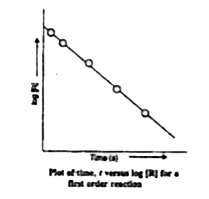Derive the integrated rate equation for the rate constant for a first order reaction. What would be units of the first order rate constant, if the concentration is expressed in moles per litre and time to seconds ? Also give graphical representation of integrated rate law equation.Solution in Punjabi
Let us consider the following hypothetical reaction of first order,
nR→Products
If the concentration of reactant, R is [R] at a particular instant of time, then instantaneous rate of reaction at that instant of time is given by the expression.
−d[R]dt=k[R]
where k is the rate constant.
Rearranging the equation, we get
−d[R]dt=kdt
On integrating the above equation.
−d[R]dt=kdt
- In [R]-kt+I
where I is the constant of integration. The value of this constant, I can be calculated from the initial conditions. When I = 0, [R] = [R]0 i.e. initial concentration of R. Thus becomes,
−In[R]0=I .....(i)
Substituting the value of I in ean. (i), we get
−In[R]=kt−In[R]0
In[R]0−In[R]=kt
or In[R]0[R]=kt
or k=1tlog([R]0)[R] ... (iii)
Converting the above expression to log to the 10, we get or k=2.303tlog([R]0)[R]
The equation (iv) is integrated .rate equation. This equation can be used to check if a given reaction is of 1st order with respect to a reactant or not.
Unit of rate constant for first order reaction.
For first order reaction
Reaction rate = k[R]
molL−1s−1=k×mol L−1
Unit of k=s−1
Graphical representation. Equation (iv) can be written as,
k2.303t=log([R]0)[R]

or k2.303t=log[R]0−log[R]
or log[R]=k2.303tlog[R]0
When a graph is plotted between log [A] (along Y-axis) and t (along X-axis) a straight line is obtained.
slope=k2.303t and Y-intercept=log [R]0
Rate constant k can be also calculated from the slope of the line so obtained.
Topper's Solved these Questions
- CHEMICAL KINETICSBOOK - BETTER CHOICE PUBLICATIONCHAPTER - CHEMICAL KINETICSEXERCISE - Numerical Problems
63 Videos
- BIOMOLECULES BOOK - BETTER CHOICE PUBLICATIONCHAPTER - BIOMOLECULES EXERCISE - QUESTION BANK
85 Videos
- CHEMISTRY IN EVERYDAY LIFEBOOK - BETTER CHOICE PUBLICATIONCHAPTER - CHEMISTRY IN EVERYDAY LIFEEXERCISE - QUESTIONS
76 Videos
Similar Questions
The rate constant of a reaction is 1.5×107sec−1 at 50∘C and 4.5×107sec−1 at 100∘C. Calculate energy of the activation for the reaction.
View SolutionCovalent compounds are soluble in
View SolutionWhat is a medicine ?
View Solutiona) Derive and expression for the integrated rate equation for 1 first order reaction.
b) Give an exmaple of pseudo first order reaction.
View SolutionDerive integrated rated equation for rate constant of a first order reaction.
View SolutionDerive the expression for integrated rate law (equation) for the first order reaction.
View SolutionIf the concentration is expressed in moles per liter, the unit of the rate constant for a first-order reaction is
View SolutionDerive an integrated rate equation for rate constant of a zero order reaction.
View SolutionDerive the integrated rate equation for rate constant of a zero reaction.
View SolutionDerive an integrated rate equation for the rate constant of a zero order reaction.
View Solutionएक जीरो आर्डर अभिक्रिया के दर स्थिरांक के लिए समाकलित दर समीकरण को व्युतपन्न कीजिये।
View SolutionDerive the integrated rate equation for rate constant of Zero order reaction.
View Solution(a) Derive the integrated rate equation for the rate constant of a first order reaction.
(b) What is pseudo first order reaction?
View SolutionDerive the integrated rate law for a first order reaction ?
View Solutionप्रथम कोटि अभिक्रिया की समाकलित दर समीकरण के लिए अभिव्यक्ति व्युत्पन्न करे|
View SolutionDerive an expression for the integral rate constant of a first order reaction.
View Solution
